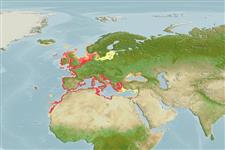Environment: milieu / climate zone / depth range / distribution range
Ekologi
laut; air tawar; payau; katadromus (ruaya dari air tawar ke laut) (Ref. 51243); kisaran kedalaman 10 - 20 m (Ref. 7399). Temperate; 64°N - 20°N, 26°W - 42°E
Eastern Atlantic: Scotland to Cape Verde; in the Mediterranean and Black Sea. Also in coastal waters from southern Norway to Morocco, rare off Mauritania (Ref. 3573). Records from the lagoon of Accra are probably misidentifications.
Length at first maturity / Size / Weight / umur
Maturity: Lm 34.0 range ? - ? cm
Max length : 61.0 cm FL jantan/; (Ref. 117745); common length : 30.0 cm SL jantan/; (Ref. 7399); Berat maksimum terpublikasi: 2.5 kg (Ref. 117745)
Duri punggung (Keseluruhan (total)): 5; duri punggung lunak (Keseluruhan (total)): 7-9; Duri dubur 3. Longer pectoral fins, lack of black spot at the pectoral fin base. Golden spot present in gill cover (Ref. 35388).
Adults are neritic usually in schools, entering lagoons and lower estuaries (Ref. 7399); rarely entering freshwater (Ref. 3573, 59043). Juveniles move to coastal lagoons and estuaries in winter and especially in spring (Ref. 59043). They feed on small benthic organisms, detritus, and occasionally on insects and plankton (Ref. 2804). Juveniles feed only on zooplankton (Ref. 59043). Reproduction takes place in the sea, from July to November. Oviparous, eggs are pelagic and non-adhesive (Ref. 205). Minimum size allowed for fishing is 20 cm. The quality of the flesh is variable (Ref. 30578).
Juveniles move to coastal lagoons and estuaries in winter and especially in spring (Ref. 59043).
Thomson, J.M., 1986. Mugilidae. p. 344-349. In J. Daget, J.-P. Gosse and D.F.E. Thys van den Audenaerde (eds.) Check-list of the freshwater fishes of Africa (CLOFFA). ISNB, Brussels, MRAC; Tervuren; and ORSTOM, Paris. Vol. 2. (Ref. 3573)
Status IUCN Red List (Ref. 130435)
ancaman kepada manusia
Harmless
penggunaan manusia
Perikanan: komersial; Budidaya air: komersial
Alat, peralatan
laporan khas
muat turun XML
Sumber internet
Estimates based on models
Preferred temperature (Ref.
123201): 9.7 - 20.7, mean 11.9 °C (based on 344 cells).
Phylogenetic diversity index (Ref.
82804): PD
50 = 0.5005 [Uniqueness, from 0.5 = low to 2.0 = high].
Bayesian length-weight: a=0.01023 (0.00856 - 0.01223), b=2.95 (2.92 - 2.98), in cm total length, based on LWR estimates for this species (Ref.
93245).
Trophic level (Ref.
69278): 2.8 ±0.33 se; based on food items.
Generation time: 5.5 (3.7 - 6.9) years. Estimated as median ln(3)/K based on 31
growth studies.
Daya lenting (Ref.
120179): sedang, Waktu penggandaan populasi minimum 1.4 - 4.4 tahun (K=0.14-0.34; tm=3-4; Fec>10,000).
Prior r = 0.77, 95% CL = 0.51 - 1.16, Based on 1 stock assessment.
Fishing Vulnerability (Ref.
59153): Moderate vulnerability (36 of 100).
Climate Vulnerability (Ref.
125649): Low to moderate vulnerability (35 of 100).
Nutrients (Ref.
124155): Calcium = 15.9 [5.1, 136.9] mg/100g; Iron = 0.255 [0.151, 0.421] mg/100g; Protein = 18.2 [16.9, 19.7] %; Omega3 = 1.21 [0.47, 3.11] g/100g; Selenium = 2.88 [1.17, 7.25] μg/100g; VitaminA = 12.9 [3.4, 52.7] μg/100g; Zinc = 0.478 [0.334, 0.670] mg/100g (wet weight); based on
nutrient studies.
